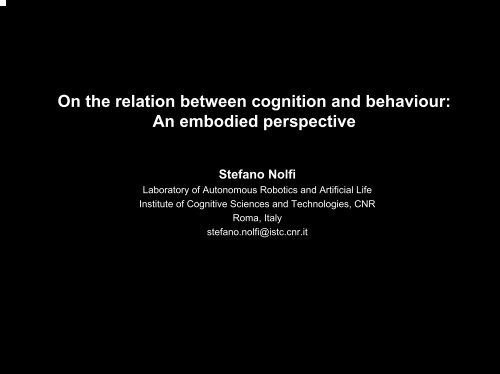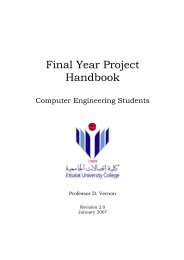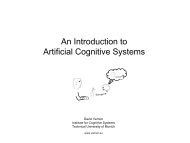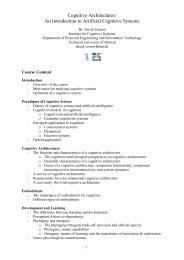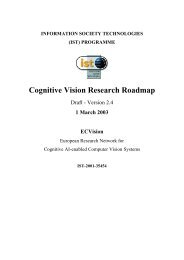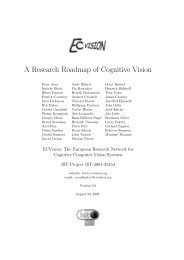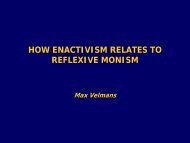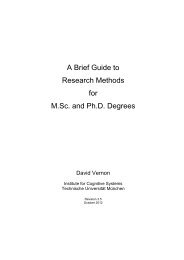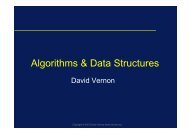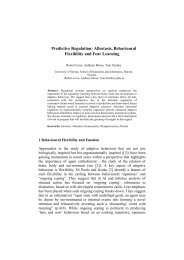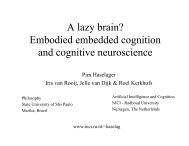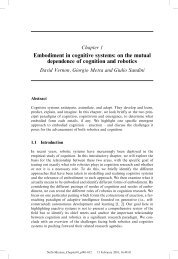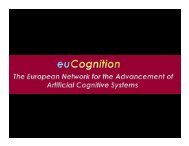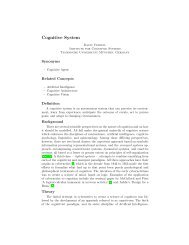On the Relation between cognition and behaviour
On the Relation between cognition and behaviour
On the Relation between cognition and behaviour
- No tags were found...
Create successful ePaper yourself
Turn your PDF publications into a flip-book with our unique Google optimized e-Paper software.
<strong>On</strong> <strong>the</strong> relation <strong>between</strong> <strong>cognition</strong> <strong>and</strong> <strong>behaviour</strong>:An embodied perspectiveStefano NolfiLaboratory of Autonomous Robotics <strong>and</strong> Artificial LifeInstitute of Cognitive Sciences <strong>and</strong> Technologies, CNRRoma, Italystefano.nolfi@istc.cnr.it
OutlineInvestigating <strong>the</strong> <strong>the</strong> relation <strong>between</strong> behavioral <strong>and</strong> <strong>and</strong> cognitiveprocesses through a syn<strong>the</strong>tic self-organizing approacha. a. The The syn<strong>the</strong>sis of of artificial agents can can be be employed as as a tool tool for for<strong>the</strong>oretical research aiming at at modeling <strong>cognition</strong> <strong>and</strong> <strong>and</strong>intelligence in in natural organismsb. b. The The identification of of new new methods that that allow artificial agents to todevelop <strong>the</strong>ir skills autonomously might lead lead to to <strong>the</strong> <strong>the</strong>development of of a new new generation of of artifacts with with <strong>the</strong> <strong>the</strong>robustness, adaptability, <strong>and</strong> <strong>and</strong> sociability of of natural organisms
Active Perception & Sensory-Motor Coordination[Franceschini [Franceschiniet et al. al. 1991] 1991][Floreano [Floreanoet et al. al. 2002-2006] 2002-2006]
The roles of sensory-motor coordination in categorizationBehavioral categorization, i.e. i.e. skills in in which behavioral differentiationarises as as a result of of sequences of of interactions <strong>between</strong> <strong>the</strong> <strong>the</strong> agent, its itsbody, <strong>and</strong> <strong>and</strong> <strong>the</strong> <strong>the</strong> environment that that are are not not mediated by by a categoricalperceptual process. [Nolfi, [Nolfi, 2002] 2002]Active categorical perception, i.e. i.e. skills in in which <strong>the</strong> <strong>the</strong> way way in in which <strong>the</strong> <strong>the</strong>agent interacts with with its its environment ensures that that <strong>the</strong> <strong>the</strong> stimuli experiencedby by <strong>the</strong> <strong>the</strong> agents present <strong>the</strong> <strong>the</strong> regularities that that can can be be used to to perceptuallydifferentiate functionally different situations. [Pfeifer [Pfeifer& Scheier, Scheier, 1997; 1997; Lungarella Lungarella& Pfeifer, Pfeifer, 2001; 2001; Beer, Beer, 2003] 2003]Action-mediated categorization, i.e. i.e. skills in in which perceptualcategories are are based on on agent/environmental regularities that that are aregenerated through agent-environmental interactions [Nolfi, [Nolfi, 2005] 2005]The The exhibition of of selected behavioral skills might facilitate <strong>the</strong> <strong>the</strong>development of of categorization abilities to to be be acquired through learning[Metta [Mettaet et al., al., 1999; 1999; Metta Metta<strong>and</strong> <strong>and</strong> Fitzpatrick, Fitzpatrick, 2003] 2003]
[Gigliotta & Nolfi, in press]<strong>On</strong> <strong>the</strong> coupling <strong>between</strong> agent/environmental<strong>and</strong> agent’s internal dynamicsEnvironmentAgent’s bodyAgent’sControlSystem brain
[Gigliotta & Nolfi, in press]<strong>On</strong> <strong>the</strong> coupling <strong>between</strong> agent/environmental<strong>and</strong> agent’s internal dynamics - 20.80.7TL0.6AL0.5I20.40.3TRACSB COD0.2TB0.100.7 0.8 0.9 1COI1
Toward <strong>the</strong> development of fully autonomousself-organzing agentsThere is is today a wide wide agreement on on <strong>the</strong> <strong>the</strong> fact fact that that behavioral, cognitive, <strong>and</strong> <strong>and</strong>social skills are are tightly interdependent phenomena that that arise from from <strong>the</strong> <strong>the</strong>interactions of of a cascade of of more elementary elements <strong>and</strong> <strong>and</strong> processes.Developing new new methods (i.e. (i.e. new new models, algorithms, <strong>and</strong> <strong>and</strong> tools) that thatallow to to syn<strong>the</strong>size self-organizing agents --- ---agents that that are are able able to todevelop <strong>the</strong>ir <strong>the</strong>ir behavioral, cognitive, <strong>and</strong> <strong>and</strong> social skills autonomously whileinteracting with with <strong>the</strong> <strong>the</strong> physical <strong>and</strong> <strong>and</strong> social environment.Identifying a limited set set of of key key processes <strong>and</strong> <strong>and</strong> mechanisms that, that, by by beingable able to to syn<strong>the</strong>size properties emerging from from <strong>the</strong> <strong>the</strong> interaction <strong>between</strong>simpler elements <strong>and</strong> <strong>and</strong> processes, might lead lead to to <strong>the</strong> <strong>the</strong> syn<strong>the</strong>sis of of artificialsystems with with a multi-level <strong>and</strong> <strong>and</strong> multi-scaled organization.


